Dive Details
Location
Date
Saturday 25 May 2019
Time
10:51am - 12:01pm
Buddy
Darko Cotoras
Seas
Strong current at times
Visibility
3 to 8 metres
Duration
70 minutes
Surface interval
Maximum depth
14.1 m
Average depth
11.2 m
Water temperature
18.4°C
Dive Profile from Citizen Hyper Aqualand
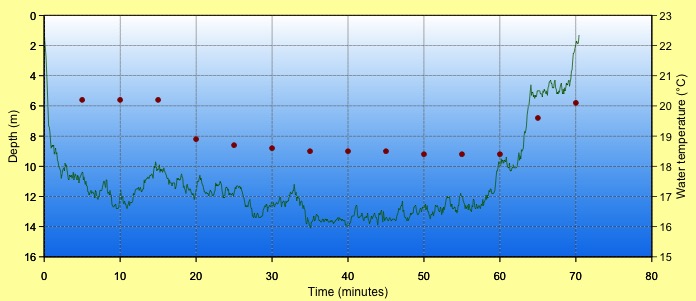
Tides at Botany Bay AEST
Note that tides at dive site may vary from above location.
High
12:18am
1.63m
Low
7:22am
0.61m
High
1:25pm
1.26m
Low
6:41pm
0.85m
Details
Today I was taking Darko for a dive at The Steps to show him what great things we have in Sydney. Darko is an arachnologist from Chile who has been working at the Museum. He dives off the coast of Chile at the same latitude as Sydney but it is a lot colder and is mainly kelp forests. I promised to show him at least one Weedy Seadragon (the juvenile near Pipefishes Hole), Red-fingered Anglerfish, a seahorse and perhaps some other cool organisms.
Conditions were calm and have been for the last week or so. I was hopeful for good visibility. I expected the water to be slightly cooler than Thursday as the swell, as slight as it was, had shifted to north-easterly which tends to bring in cooler water.
We jumped in at The Steps and put our fins on in the water. We swam out on the surface where the visibility looked quite good. We descended and swam into the kelp. The visibility was only 5 to 8 metres but still OK. The water temperature was around 20°C. There was some current but basically no surge. I led the way down to the sand line.
We followed the sand/kelp line towards Big Rock. I was looking for Weedy Seadragons as we went. Just after the rocks where the other seahorses used to be I spotted a juvenile Weedy Seadragon. It was not the same one that has been near Pipefishes Hole. This one had appendages on its snout and the second appendage on its head was flat on top. Darko seemed thrilled to see it.

Juvenile Weedy Seadragon, Phyllopteryx taeniolatus. 11.8 m.
We continued along the sand line to Pipefishes Hole. I noticed the Sawtooth Pipefish in the hole and pointed them out to Darko but it was difficult to explain what he was looking at and they are so small. I looked around for the juvenile Weedy Seadragon and found it just past the hole. I showed it to Darko.
We swam up to the rock next to the rock above Pipefishes Hole. The small orange Red-fingered Anglerfish was back hiding in the sponge. I took some photographs and pointed it out to Darko.
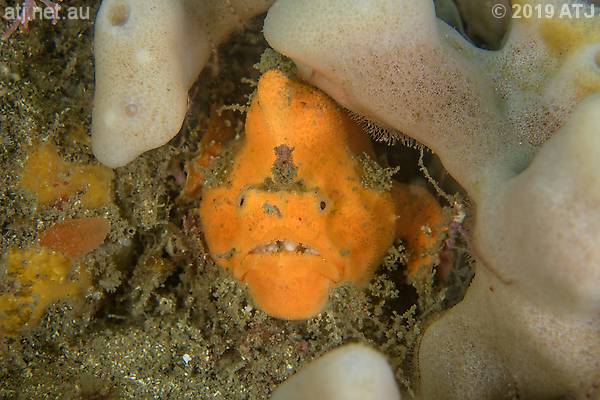
Red-fingered Anglerfish, Porophryne erythrodactylus. 11.5m.
We kept heading up the reef to Di's Rock. The large orange Red-fingered Anglerfish was hanging under the side of the rock. Again I took photographs and showed it to Darko.
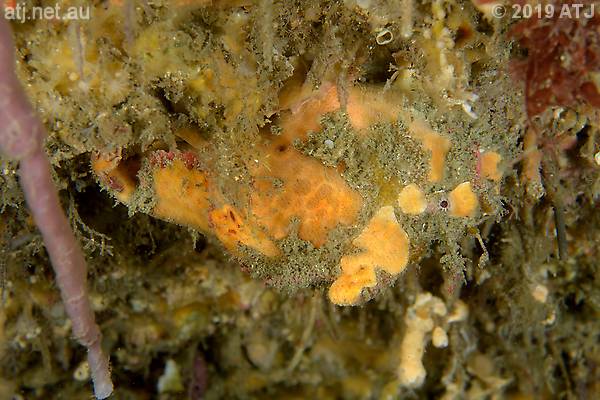
Red-fingered Anglerfish, Porophryne erythrodactylus. 10.6m.
We followed the top of the reef to the rocks behind Little Big Rock. The large yellow Red-fingered Anglerfish was in the same spot on the rock with the large green sponge as it had been on Thursday but it was facing up the rock. More photographs and indicating it to Darko. He was impressed with how large she is. By now the temperature had dropped below 19°C.
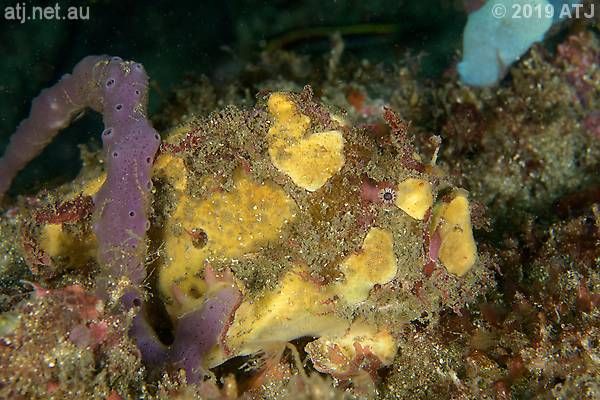
Red-fingered Anglerfish, Porophryne erythrodactylus. 10.9m.
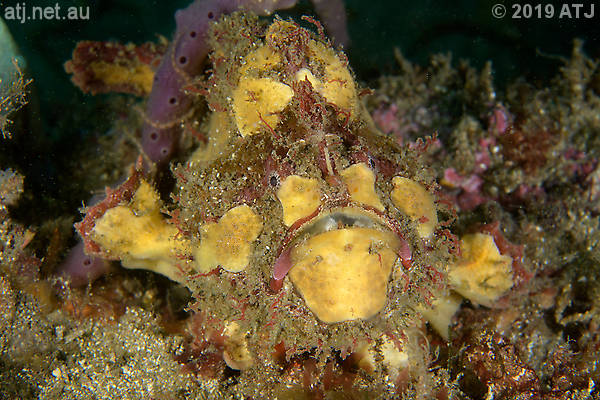
Red-fingered Anglerfish, Porophryne erythrodactylus. 10.8m.
We headed over to the rocks where "David", the Pot-bellied Seahorse, usually hangs out. He was in the purple sponge on the lower rock. I took some photographs and as Darko was looking at him a school of Yellowtail Kingfish buzzed us. I had told Darko about them before the dive but thought it was only a possibility. I called out to him and he looked up just in time to see them swimming away.
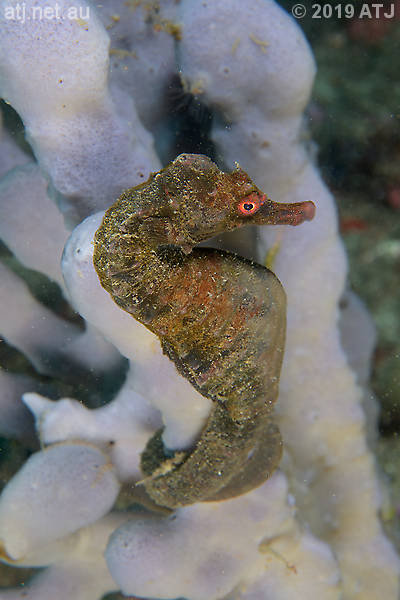
Male Pot-bellied Seahorse, Hippocampus abdominalis, ("David"). 11.6m.
We swam on towards the basket star. While we were out on the sand the kingfish came back and buzzed us a lot more. They circled for quite a while and circled Darko in particular. He was thrilled with this. (See video below.)
We visited the basket star and I had a quick look around New Basket Star Rock for the large orange Red-fingered Anglerfish I'd found last weekend. I couldn't see it.

Basket star, Astrosierra amblyconus. 11.9m.
We headed down towards the sand line and Diversity Rock. I spotted a small Giant Cuttlefish on the way.
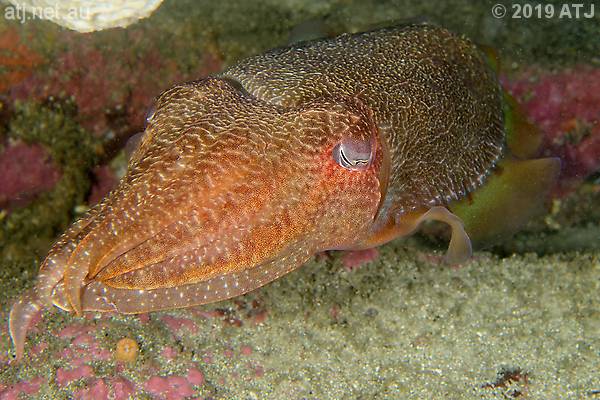
Giant Cuttlefish, Sepia apama. 12.6m.
I didn't find anything of interest around Diversity Rock but as we started on towards Big Rock I spotted the small orange Red-fingered Anglerfish with the black spot under its right eye. This made 4 anglerfish for the dive.

Red-fingered Anglerfish, Porophryne erythrodactylus. 13.1m.
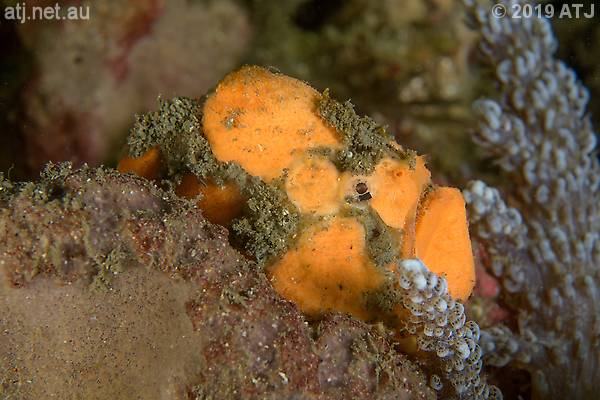
Red-fingered Anglerfish, Porophryne erythrodactylus. 13.4m.
We swam along the top of the reef past Sponge Hollow and on to the rock where the one-eyed seahorse used to be. I was looking for pygmy pipehorses along the way as I really wanted to show them to Darko. As we approached the rock where the one-eyed seahorse had been I spotted George's orange Red-fingered Anglerfish. This made 5.
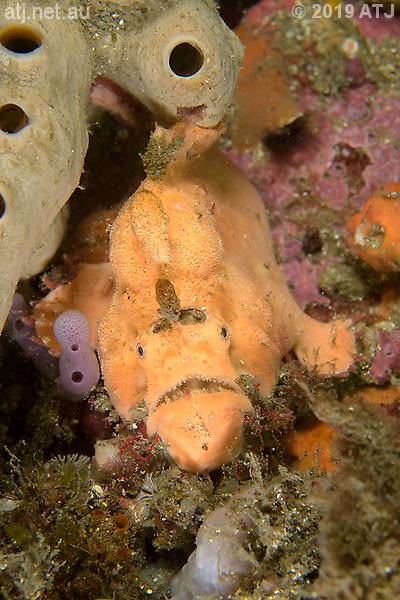
Red-fingered Anglerfish, Porophryne erythrodactylus. 11.8m.
We continued past High Pygmy Rock, Slope Rock and on to Hand Rock. I looked carefully for pygmy pipehorses on Hand Rock but found none.
We turned around and headed back to the exit. I looked for the salmon Red-fingered Anglerfish that had been on Slope Rock but I had seen on Thursday on a lower rock. We stayed at around 14 metres and a few rocks farther along I spotted another small orange Red-fingered Anglerfish. This must be the one Mike had found. This made 6 for the dive.

Red-fingered Anglerfish, Porophryne erythrodactylus. 13.4m.

Red-fingered Anglerfish, Porophryne erythrodactylus. 13.6m.
We followed the reef back to the orange anglerfish with the black dot under its right eye and then continued just above the sand line to Little Big Rock. I looked on Little Big Rock for pygmy pipehorses but only found a Phyllodesmium poindimiei nudibranch. They are not uncommon but this one was in a good spot for photography.
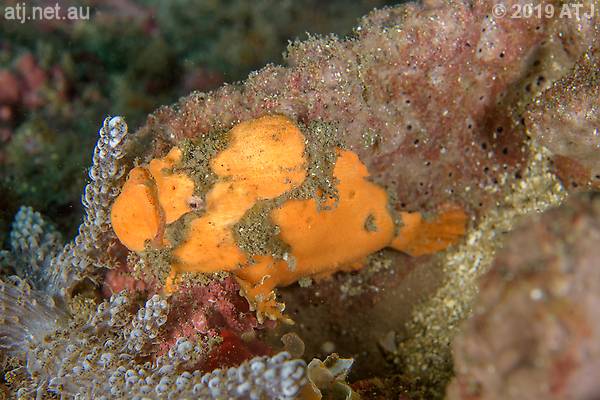
Red-fingered Anglerfish, Porophryne erythrodactylus. 13.4m.
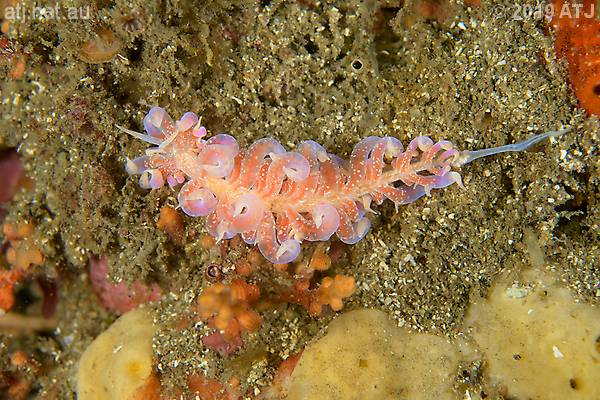
Nudibranch, Phyllodesmium poindimiei. 12.7m.
We continued along the sand line to Pipefishes Hole and the juvenile Weedy Seadragon there. We then swam on to the new juvenile weedy we'd seen early in the dive.
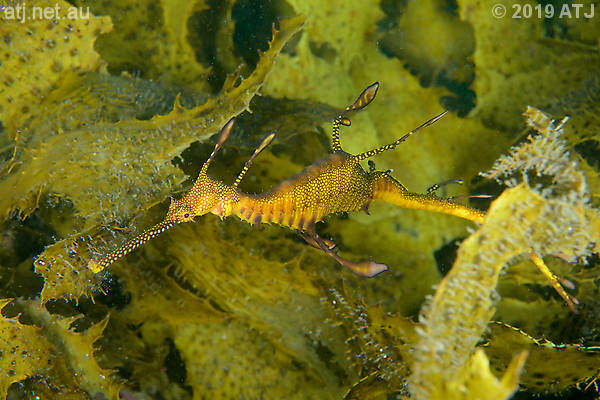
Juvenile Weedy Seadragon, Phyllopteryx taeniolatus. 12.6 m.
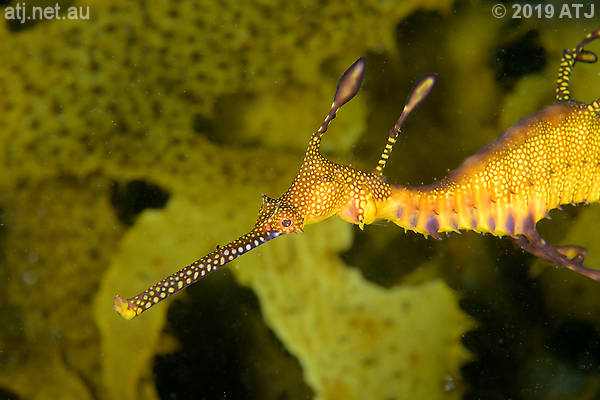
Juvenile Weedy Seadragon, Phyllopteryx taeniolatus. 12.7 m.
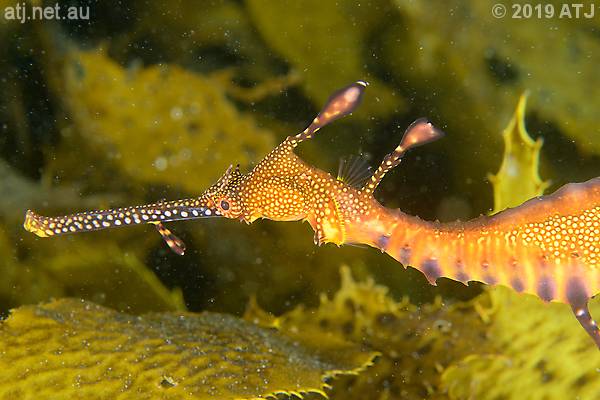
Juvenile Weedy Seadragon, Phyllopteryx taeniolatus. 11.7 m.
We swam past the rocks where the other seahorses used to be and then on to rocks where I last saw the "map of Australia" orange Red-fingered Anglerfish. We headed past the rocks in front of the exit and then to the boulders where we ascended to Split Rock. We did our safety stop and then swam underwater to the exit where we got out.
Camera gear
Camera
Nikon D500
Lens
Nikon AF-S Micro Nikkor 60mm f/2.8G ED
Housing
Ikelite 6812.5
Lens port
Ikelite Flat Port 5502.41
Strobe(s)
2 x Ikelite SubStrobe DS161
Video